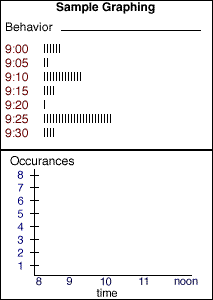| ESE502 : The Class : Structure : Management Plan | |||||
 Management
Plan
Management
Plan
Occasionally, student problems appear so complex that a behavior assessment
is called for.
The following steps simplify the process.
- Identify student
- Fill out and use a Behavior Assessment Form
- Define the behaviors to be observed (base record)
- Set up a schedule of timing for observing the student's behaviors.
Example: 30 seconds of every other minute; 1 minute in five minutes - If possible observe the student in several settings.
- Complete the observations using a Behavior Graphing Form.
- Analyze the findings.
- Develop the Behavior Enhancement system with the student (and with a team, if possible).
Remember to stay with five behaviors or less. - Develop a Contract.
- Hold a meeting with the teachers, parents, student and administration.
- Implement
- Periodically review and adjust.
| Student observed Date | |
| Teacher Time of day | |
|
Behavioral excesses: (Ex: talking, off task, attention seeking,
touching others) Behavioral deficits: (Ex: not responded, tardy, work not completed,
refusing to cooperate, not following rules) Motivation: (Ex: common ones are attention, power, anger, hostility,
depressed, uncertain of task, feeling incapable, need for stimulation)
Teacher antecedents or responses: (Ex: monitor teacher behaviors
that precede student misbehavior and also watch for any "payoffs"
the teacher is supplying inadvertently) |

|
Once you have finished, you should:
Go on to Consequences
or
Go back to Reading
 E-mail J'Anne Ellsworth
at jet@sedona.net
E-mail J'Anne Ellsworth
at jet@sedona.net
Web site created by the NAU OTLE Faculty Studio
Copyright 1998 Northern Arizona University
ALL RIGHTS RESERVED
